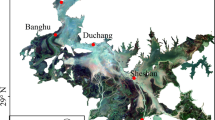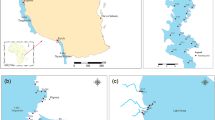Abstract
Freshwater lakes play a vital role in global hydrological and biogeochemical cycles, serving various functions and maintaining ecological balance. However, freshwater resources are more vulnerable to deterioration due to multiple stressors. Gaoyou Lake is one of the impounded lakes of the Eastern route of South-to-North Water Diversion Project in China, and as an important source of drinking water, the lake has been routinely monitored. Long-term monitoring of water quality in Gaoyou Lake showed that concentrations of nutrients and chlorophyll a as well as trophic state in the water column increased while water transparency decreased, indicating that the water quality has declined during the last 12 years. Specifically, there was a notable and statistically significant increase in chlorophyll a concentrations, averaging an annual rate of 9.9%. Despite a slight decline in trophic level index until 2014, subsequent years saw an upward trend, ranging from 50.7 to 56.4 and indicating a light eutrophic state. Spatially, the western area displayed higher nutrient and chlorophyll a concentrations. Changes in hydro-meteorological variables and nutrients from inflowing rivers were the main factors correlated with water quality in Gaoyou Lake. Thus, pollution source apportionment and management within Huaihe River basin should be considered to reduce the external loadings of nutrients in order to improve and sustain long-term water quality.






Similar content being viewed by others
Data availability
The datasets are available from the corresponding author on reasonable request but are not publicly available.
References
Beyhan M, Kaçıkoç M (2014) Evaluation of water quality from the perspective of eutrophication in Lake Eğirdir, Turkey. Water, Air Soil Pollution 225(7):1994. https://doi.org/10.1007/s11270-014-1994-x
Blenckner T (2005) A conceptual model of climate-related effects on lake ecosystems. Hydrobiologia 533(1):1–14. https://doi.org/10.1007/s10750-004-1463-4
Breiman L (2001) Random forests. Mach Learn 45(1):5–32. https://doi.org/10.1023/A:1010933404324
Carpenter SR et al (1998) Ecological and economic analysis of lake eutrophication by nonpoint pollution. Aust J Ecol 23(1):68–79. https://doi.org/10.1111/j.1442-9993.1998.tb00706.x
Chang F-J, Chang Y-T (2006) Adaptive neuro-fuzzy inference system for prediction of water level in reservoir. Adv Water Resour 29(1):1–10. https://doi.org/10.1016/j.advwatres.2005.04.015
Chen Y, Guan Y, Miao J, Zhang D (2017) Determination of the ecological water-level and assuring degree in the Lake Gaoyou, northern Jiangsu with long-term hydrological alteration. J Lake Sci 29(2):398–407. https://doi.org/10.18307/2017.0216
Chen Y, Chen Z, Ma D, Yin H, Wu C (2022) Remote sensing estimation of water quality parameters in Gaoyou Lake based on Sentinel-2 MSI data. Environ Sci Manag 7:77–81. https://doi.org/10.3969/j.issn.1673-1212.2022.07.017
Cutler DR et al (2007) Random forests for classification in ecology. Ecology 88(11):2783–2792. https://doi.org/10.1890/07-0539.1
Elliott JA, Defew L (2012) Modelling the response of phytoplankton in a shallow lake (Loch Leven, UK) to changes in lake retention time and water temperature. Hydrobiologia 681(1):105–116. https://doi.org/10.1007/s10750-011-0930-y
Fu B, Lao Z, Liang Y, Sun J, He X, Deng T, He W, Fan D, Gao E, Hou Q (2022) Evaluating optically and non-optically active water quality and its response relationship to hydro-meteorology using multi-source data in Poyang Lake China. Ecol Indicat 145:109675. https://doi.org/10.1016/j.ecolind.2022.109675
Fu B, Li S, Lao Z, Yuan B, Liang Y, He W, Sun W, He H (2023) Multi-sensor and multi-platform retrieval of water chlorophyll a concentration in karst wetlands using transfer learning frameworks with ASD, UAV, and Planet CubeSate reflectance data. Sci Total Environ 901:165963. https://doi.org/10.1016/j.scitotenv.2023.165963
Gao K et al (2021) A study on the collaborative control of water quality of nitrogen and phosphorus between typical lakes and their inflow rivers in China. J Lake Sci 33(5):1400–1414
Geng M et al (2021) Is water quality better in wet years or dry years in river-connected lakes? A case study from Dongting Lake China. Environ Pollut 290:118115. https://doi.org/10.1016/j.envpol.2021.118115
Guildford SJ, Hecky RE (2000) Total nitrogen, total phosphorus, and nutrient limitation in lakes and oceans: is there a common relationship? Limnol Oceanogr 45(6):1213–1223. https://doi.org/10.4319/lo.2000.45.6.1213
Guo C et al (2020a) Patterns of fish communities and water quality in impounded lakes of China’s south-to-north water diversion project. Sci Total Environ 713:136515. https://doi.org/10.1016/j.scitotenv.2020.136515
Guo C et al (2020b) Eutrophication and heavy metal pollution patterns in the water suppling lakes of China’s south-to-north water diversion project. Sci Total Environ 711:134543. https://doi.org/10.1016/j.scitotenv.2019.134543
Han Y et al (2022) Combining lanthanum-modified bentonite (LMB) and submerged macrophytes alleviates water quality deterioration in the presence of omni-benthivorous fish. J Environ Manag 314:115036. https://doi.org/10.1016/j.jenvman.2022.115036
He H et al (2022) The influence of spring warming and food chain length on plankton phenology in subtropical shallow lakes: a mesocosm study. J Plankton Res 44(1):73–87. https://doi.org/10.1093/plankt/fbab078
Heisler J, Glibert PM, Burkholder JM, Anderson DM, Cochlan W (2008) Eutrophication and harmful algal blooms: a scientific consensus. Harmful Algae 8:3–13. https://doi.org/10.1016/j.hal.2008.08.006
Hu X et al (2022) Phytoplankton community variation and ecological health assessment for impounded lakes along the eastern route of China’s South-to-North Water Diversion Project. J Environ Manag 318:115561. https://doi.org/10.1016/j.jenvman.2022.115561
Jeppesen E et al (2010) Impacts of climate warming on lake fish community structure and potential effects on ecosystem function. Hydrobiologia 646(1):73–90. https://doi.org/10.1007/s10750-010-0171-5
Jin X, Tu Q (1990) The standard methods for observation and analysis of lake eutrophication, 2nd ed. (In Chinese). China Environmental Science Press, Beijing, China
Kong X et al (2017) Hydrological regulation drives regime shifts: evidence from paleolimnology and ecosystem modeling of a large shallow Chinese lake. Global Change Biol 23(2):737–754. https://doi.org/10.1111/gcb.13416
Latuso KD, Keim RF, King SL, Weindorf DC, DeLaune RD (2017) Sediment deposition and sources into a Mississippi River floodplain lake; Catahoula Lake, Louisiana. CATENA 156:290–297. https://doi.org/10.1016/j.catena.2017.04.020
Le C et al (2009) A four-band semi-analytical model for estimating chlorophyll a in highly turbid lakes: the case of Taihu Lake China. Remote Sens Environ 113(6):1175–1182. https://doi.org/10.1016/j.rse.2009.02.005
Lefcheck JS (2016) piecewiseSEM: piecewise structural equation modelling in R for ecology, evolution, and systematics. Methods Ecol Evol 7(5):573–579. https://doi.org/10.1111/2041-210X.12512
Lefcheck J, Byrnes J, Grace J (2020) PiecewiseSEM: piecewise structural equation modeling. https://CRAN.R-project.org/package=piecewiseSEM
Li Y et al (2004) On the relation between the release rate of TN TP from sediment and water velocity. J Lake Sci 16(4):318–324. https://doi.org/10.18307/2004.0405
Li S, Guo W, Mitchell B (2011) Evaluation of water quality and management of Hongze Lake and Gaoyou Lake along the Grand Canal in Eastern China. Environ Monitor Assess 176(1–4):373–384. https://doi.org/10.1007/s10661-010-1590-5
Li Y et al (2021) Water quality change and driving forces of Lake Hongze from 2012 to 2018. J Lake Sci 33(3):715–726. https://doi.org/10.18307/2021.0308
Liao G (1992) Formation and evolution of the Gaoyou Lake Jiangsu province. Acta Geogr Sinica 47(2):139–145
Lürig MD, Best RJ, Dakos V, Matthews B (2021) Submerged macrophytes affect the temporal variability of aquatic ecosystems. Freshwater Biol 66(3):421–435. https://doi.org/10.1111/fwb.13648
Qin B et al (2010) A drinking water crisis in Lake Taihu, China: linkage to climatic variability and lake management. Environ Manag 45(1):105–112. https://doi.org/10.1007/s00267-009-9393-6
Qu X et al (2020) A holistic assessment of water quality condition and spatiotemporal patterns in impounded lakes along the eastern route of China’s South-to-North water diversion project. Water Res 185:116275. https://doi.org/10.1016/j.watres.2020.116275
Shalby A, Elshemy M, Zeidan BA (2020) Assessment of climate change impacts on water quality parameters of Lake Burullus Egypt. Environ Sci Pollut Res 27(26):32157–32178. https://doi.org/10.1007/s11356-019-06105-x
Søndergaard M, Larsen SE, Jørgensen TB, Jeppesen E (2011) Using chlorophyll a and cyanobacteria in the ecological classification of lakes. Ecol Indicat 11(5):1403–1412. https://doi.org/10.1016/j.ecolind.2011.03.002
Søndergaard M, Lauridsen TL, Johansson LS, Jeppesen E (2017) Nitrogen or phosphorus limitation in lakes and its impact on phytoplankton biomass and submerged macrophyte cover. Hydrobiologia 795(1):35–48. https://doi.org/10.1007/s10750-017-3110-x
Tian C-C, Guo C-B, Wu X-Q (2019) Distribution of submerged plants and its relationship with environmental factors in Gaoyou Lake. Acta Hydrobiol Sinica 43(2):423–430. https://doi.org/10.7541/2019.052
Todd AS et al (2012) Climate-change-driven deterioration of water quality in a mineralized watershed. Environ Sci Technol 46(17):9324–9332. https://doi.org/10.1021/es3020056
Tranvik LJ et al (2009) Lakes and reservoirs as regulators of carbon cycling and climate. Limnol Oceanogr 54(6part2):2298–2314. https://doi.org/10.4319/lo.2009.54.6_part_2.2298
Vörösmarty CJ et al (2010) Global threats to human water security and river biodiversity. Nature 467:555–561. https://doi.org/10.1038/nature09440
Wang M, Liu X, Zhang J (2002) Evaluate method and classification standard on lake eutrophication. Environ Monit China 18(5):47–49
Wang S et al (2021) Water level as the key controlling regulator associated with nutrient and gross primary productivity changes in a large floodplain-lake system (Lake Poyang) China. J Hydrol 599:126414. https://doi.org/10.1016/j.jhydrol.2021.126414
Wei J et al (2022) Determining heavy metal pollution in sediments from the largest impounded lake in the eastern route of China’s South-to-North Water Diversion Project: ecological risks, sources, and implications for lake management. Environ Res 214:114118. https://doi.org/10.1016/j.envres.2022.114118
Wilson CO, Weng Q (2011) Simulating the impacts of future land use and climate changes on surface water quality in the Des Plaines River watershed, Chicago Metropolitan Statistical Area Illinois. Sci Total Environ 409(20):4387–4405. https://doi.org/10.1016/j.scitotenv.2011.07.001
Wu Z, Lai X, Zhang L, Cai Y, Chen Y (2014) Phytoplankton chlorophyll a in Lake Poyang and its tributaries during dry, mid-dry and wet seasons: a 4-year study. Knowl Manag Aquat Ecosyst 412:06. https://doi.org/10.1051/kmae/2013088
Wu Z, Wang X, Chen Y, Cai Y, Deng J (2018) Assessing river water quality using water quality index in Lake Taihu Basin, China. Sci Total Environ 612:914–922. https://doi.org/10.1016/j.scitotenv.2017.08.293
Wu T, Wang S, Su B, Wu H, Wang G (2021) Understanding the water quality change of the Yilong Lake based on comprehensive assessment methods. Ecol Indic 126:107714. https://doi.org/10.1016/j.ecolind.2021.107714
Xia W et al (2022) Climate, hydrology, and human disturbance drive long-term (1988–2018) macrophyte patterns in water diversion lakes. J Environ Manag 319:115726. https://doi.org/10.1016/j.jenvman.2022.115726
Xu L et al (2012) Water quality parameters response to temperature change in small shallow lakes. Phys Chem Earth, Parts a/b/c 47–48:128–134. https://doi.org/10.1016/j.pce.2010.11.005
Xu H et al (2021) Contributions of external nutrient loading and internal cycling to cyanobacterial bloom dynamics in Lake Taihu, China: implications for nutrient management. Limnol Oceanog 66(4):1492–1509. https://doi.org/10.1002/lno.11700
Xu Y et al (2023) Assessment of the spatiotemporal water quality variations in the Middle Route of China’s South-to-North Water Diversion Project by multivariate analysis. Environ Sci Pollut Res 30(15):44206–44222. https://doi.org/10.1007/s11356-022-25115-w
Yu Z et al (2017) Characteristics of nutrient release from sediments under different flow conditions. Chem Spec Bioavail 29(1):70–77. https://doi.org/10.1080/09542299.2017.1320950
Zhang Q (2009) The South-to-North Water Transfer Project of China: environmental implications and monitoring strategy. JAWRA J Am Water Resour Assoc 45(5):1238–1247. https://doi.org/10.1111/j.1752-1688.2009.00357.x
Zhang X, Wang G, Tan Z, Wang Y, Li Q (2021) Effects of ecological protection and restoration on phytoplankton diversity in impounded lakes along the eastern route of China’s South-to-North Water Diversion Project. Sci Total Environ 795:148870. https://doi.org/10.1016/j.scitotenv.2021.148870
Zhu W, Pang W, You Q, Wang Q (2017) Phytoplankton community structure and the evaluation of water quality in spring Huaihe River Basin. J Lake Sci 29(3):637–645. https://doi.org/10.18307/2017.0312
Zuo D et al (2022) Identification of priority management areas for non-point source pollution based on critical source areas in an agricultural watershed of Northeast China. Environ Res 214:113892. https://doi.org/10.1016/j.envres.2022.113892
Acknowledgements
The authors thank Professor Richard K. Johnson for linguistic assistance.
Funding
This study was financially supported by the Water Conservancy Science and Technology Program of Jiangsu Province (2022068, 2021037), the National Natural Science Foundation of China (32371638), the Key Laboratory of Lake and Watershed Science for Water Security (NKL2023-ZD02), and the Youth Innovation Promotion Association of Chinese Academy of Sciences (2020316).
Author information
Authors and Affiliations
Contributions
You Zhang: conceptualization; data curation; formal analysis; funding acquisition; methodology; software; writing—original draft. Mingyuan Gao: data curation. Rongkun Liu: data curation; formal analysis. Ping Cai: data curation. Junfeng Gao: data curation. Kuanyi Li: writing—review and editing. Yongjiu Cai: conceptualization; funding acquisition; writing—review and editing.
Corresponding author
Ethics declarations
Conflict of interest
The authors declare no competing interests.
Additional information
Responsible Editor: Xianliang Yi
Publisher's Note
Springer Nature remains neutral with regard to jurisdictional claims in published maps and institutional affiliations.
Rights and permissions
Springer Nature or its licensor (e.g. a society or other partner) holds exclusive rights to this article under a publishing agreement with the author(s) or other rightsholder(s); author self-archiving of the accepted manuscript version of this article is solely governed by the terms of such publishing agreement and applicable law.
About this article
Cite this article
Zhang, Y., Gao, M., Liu, R. et al. Hydro-meteorological factors and inflowing nutrients drive water quality in an impounded lake of China’s South-to-North Water Diversion Project. Environ Sci Pollut Res 31, 28198–28209 (2024). https://doi.org/10.1007/s11356-024-33028-z
Received:
Accepted:
Published:
Issue Date:
DOI: https://doi.org/10.1007/s11356-024-33028-z




